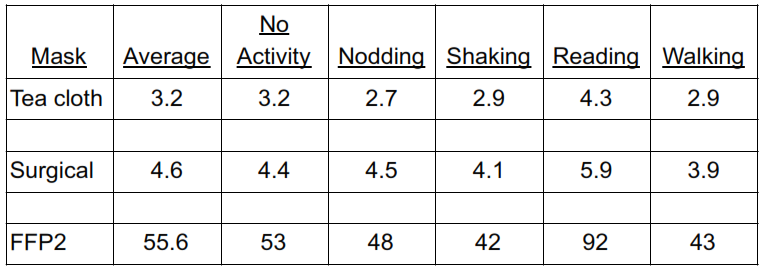If you’re looking for info on how to make masks & where to get supplies (in Hamilton) see here.
Study 1: Transmission Reduction Potential of FFP2 (N-95 equivalent), homemade and surgical masks.
Reference: R Sabel Plos One 2008:3(7):e2618
Aim
To assess the transmission reduction potential of FFP2 masks vs surgical masks vs home-made masks.
Methods
Assessed transmission reduction potential provided by personal respirators surgical masks and home-made masks when worn during a variety of activities by healthy volunteers and a simulated patient.
Long-term protection was assessed during 3 hours of regular activity by a volunteer.
Protection factor was assessed measuring particle concentration inside and outside the mask with PF = 1 meaning complete absence of protection (ie the higher the number the better)
The table below shows the average of the median protection factors after 3 hours of a combination of various activities:

Study 2: Efficacy of Homemade Masks & Protection form an Influenza Pandemic
Aim
To compare homemade masks to surgical masks.
Reference: A Davies Disaster Med Public Health Preparedness 2013:0:1-6
Methods
In the first part of the experiment, different materials were compared in terms of filtration efficiency (for bacteria and an RNA bacteriophage as well as pressure Drop across fabric.
In the second part of the study, a homemade mask (made out of 100% cotton T-shirt material) was compared to a surgical mask.
Results
The table below lists the Mean % Filtration efficiency to an RNA bacteriophage of different materials:

The fit factor of homemade and surgical masks was then compared as well as a comparison to no mask. A ‘Fit Factor’ (FF) was calculated (high number = better fit):
When compared, homemade masks had a FF of 2.0 vs 5.0 for surgical masks
They then had volunteers cough & looked at the median number of colony forming units (CFUs) isolated from volunteers coughing when wearing a surgical mask, a homemade mask, and no mask:
Comparing No mask vs Homemade mask median CFUs was 2.0 vs 1.0 (P=0.04)
When comparing No mask vs Surgical mask, median CFUs was 2.0 vs 0.9 (P<0.001)
When comparing the total number of CFUs of different sizes isolated from 21 volunteers coughing when wearing No mask vs Homemade mask vs Surgical mask they saw 200 vs 43 vs 30 CFU.
Thus in all the measures, a homemade mask was better than no mask, but worse than a surgical mask.
If you’re looking for info on how to make masks & where to get supplies (in Hamilton) see here.